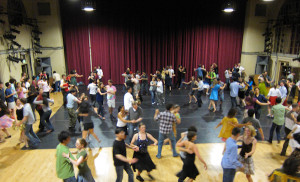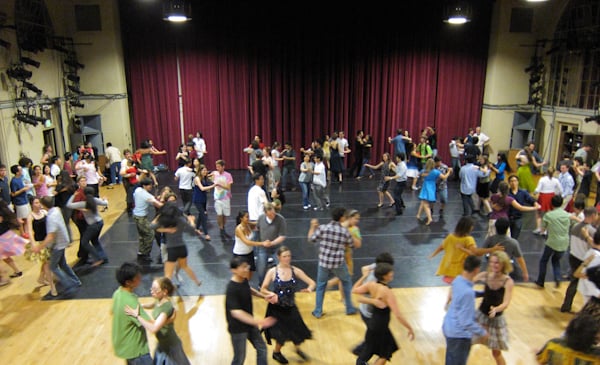Gliding across the floor, I hold on tightly as my partner leads the way. After several turns, claps, stomps and bows, the music stops, and, to my astonishment, the crowd cheers. No matter how fleeting or spontaneous the moment, I will always remember the first time I danced the Bohemian National Polka.
I credit this experience to Cameron Schaeffer ’11, a social dance aficionado. The site was Jammix, a Stanford event that features social dancing once a month in Roble Gym. Schaeffer assured me that newcomers are encouraged to join even if they don’t know the dance.
“Unlike other ballroom venues, Jammix is about having fun, pleasing your partner and goofing off,” Schaeffer said.
Students may be hesitant to initially attend Jammix, partly because of the high skill level of many other social dancers.
“Upon entering the room, it can be pretty intimidating,” said participant Rebekah Oragwu ’15, “but then people come up to you and guide you as you stumble and laugh during the rotary waltz, and suddenly it’s just fun.”
The event draws participants from all over campus and from all sectors of the Stanford population–from computer scientists to dance majors.
Stanford’s enthusiasm for social dance comes from the popular class Social Dances of North America, taught by dance instructor Richard Powers M.S. ’70. The typical class enrollment ranges from 120 to 130 students each quarter.
“[Social dance at Stanford] all starts and ends with Richard Powers, a vintage dance instructor, ex-product designer and dance historian who revived and taught social dance when he joined the Stanford faculty in 1992,” said participant Acata Felton ’12.
The walls inside Powers’ office are covered with vintage posters depicting different ballroom dances from across the world. Little figurines of dancers line the shelf. As a graduate student at Stanford, Powers studied the creative process in engineering, art and philosophy. After he graduated, Powers went into the field of engineering, from which he received seven design and twenty director awards.
His first foray into movement art was tai chi, evolving from his study of Japanese and Chinese calligraphy. He quickly discovered his love of dancing with other people.
“At that time, I also loved history,” Powers said. “I took a historic dance workshop on East Coast Renaissance and Baroque dance and pushed into 19th-century ragtime-era social dance, which at the time was a black sheep for the scholars.”
Today Powers also offers courses on the history of social dance that students describe as fun, contemporary and engaging. His choice to jump from engineer to dance instructor and historian stems from a desire “to do the most good while doing the least harm,” he said.
According to Powers, the social dance classes are not solely recreational, but also a great stress reliever that offers students valuable skills in ballroom dancing–and life.
“A significant aspect of social dance is the ability to adapt to new partners,” Powers said, remarking that making split-second decisions makes one not only a better dancer, but also a better thinker.
Jammix is a space where students who take Social Dances of North America can practice, share steps they’ve picked up and invent new ones. Attendees generally consist of current students and local alumni who come back to campus just for the night.

Music is a key component of the Jammix experience. While Powers, who acts as disc jockey for the event, has a set playlist, he also must read the energy of the crowd when selecting songs. He aims to choose music that is “current, whimsical and danceable,” featuring an eclectic mix of techno, Hindi pop, K-pop, swing, Latin salsa and everything in between. Visitors who walk into Roble Gym during Jammix might be surprised to view a roomful of couples swinging to Lady Gaga’s “Poker Face” or performing the cha-cha to Marc Anthony.
In terms of dance styles, students usually engage in the swing, waltz, tango, salsa, cha-cha and Irish line dances. When a song turns on, Roble Gym freezes for a moment as dancers feel the pulse of the music, and then the room immediately erupts into movement. As the beat of some songs can be applied to various dances, not all couples may choose the same step, resulting in hazardous situations: not infrequently, energetic dancers who opt for the galloping polka may collide with more stationary swingers.
Yet dancing is not the only attraction of Jammix.
“I came for the dancing, I stayed for the people,” Felton said.
Along the sidelines of the dance floor, individuals congregate to chat while taking a break from the vigor of social dancing. Jammix and other dance events and classes have created a unique sort of social dance community on campus.
For Powers, as a dance historian, the beauty of Jammix lies in the recreation of scenes from paintings and lithographs at the height of the 19th-century dance craze in Paris.
“I was hit by the rush of 200 young dancers swirling around with a combination of that much skill, enthusiasm and care for their dance partners,” Powers said.
